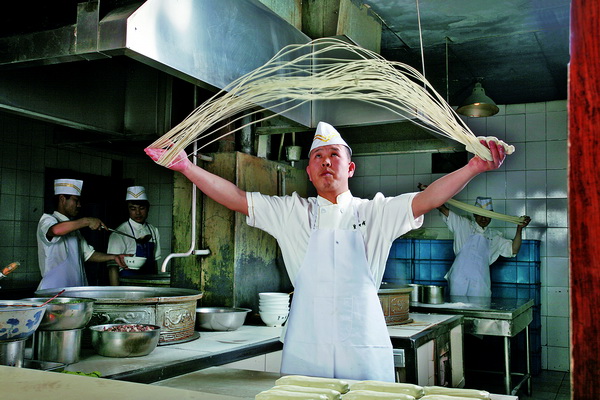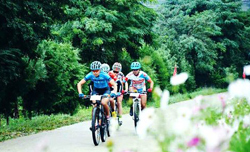Specialties
Gansu Cuisine
Updated: 2013-11-04Lanzhou dishes
Lanzhou dishes are representative of Gansu cuisine which features the roasting, steaming, and braising of beef and mutton. Lanzhou people enjoy many tastes including salty, fresh, tart, and spicy. Gansu cuisine can be sampled at various hotels in Lanzhou. Typical dishes include Jincheng Baita, Jincheng Babao Melon Carving, Baihe Tao, and albino leeks with chicken and roasted pork.
The food in Lanzhou is quite unique compared to that of central China, having been influenced by ethnic groups - especially the Hui people. Besides the beef noodles, there are local delicacies that cannot be tasted in other places, as well as Sichuan cuisines, hotpot, and western food.
Jinyu (golden fish) Facai (a kind of fungus that grows in the desert near the Yellow River) is a classic dish in Gansu province. There is no golden fish in the dish; the name comes from the shape. The Fa Cai is soaked in water until it is soft and then kneaded until it is round. Minced chicken flavored with salt, egg white, sesame oil, and cooking wine is used to stuff the Fa Cai so it looks like a golden fish. The'fish' is steamed until it is cooked and then served in a dish surrounded with bree, giving the look of a 'golden fish swimming in water'. This popular Lanzhou dish goes well with wine.
Jincheng Baita is an assortment of cold meats, imitating the famous attraction of Baita (the White Pagoda) in Lanzhou, which is a seven-story pagoda with eight facets.
Jincheng Babao (eight treasures) Melon Carving is a traditional food of Lanzhou. The carved melon peel is used as a bowl to hold white fungus, pineapple, cherry, longan, waxberry, and other delicacies. The carving is exquisite and the food is fresh and sweet. This dish will satisfy not only your palate but also your eye.
Silk Road Camel Hoof is a nutritious dish since the whole hoof is made up of tendon, which is very tasty. Quick Fried Camel Hump, a dainty dish, has a history of 1,500 years.
Baihe (Lily) Tao (Peach) is so named because the dish is shaped like peaches. The washed fresh lily - a specialty of Lanzhou - is steamed for about 15 minutes. The lily is then stuffed with sweetened bean paste so that it looks like a peach. The 'peach' is braised in a bamboo steamer for about twenty minutes and then served with a white sugar sauce.
Lanzhou Beef Noodles (Stretched Noodles) is the most famous local dish in Lanzhou. It was first created during the reign of Emperor Guangxu (1875 - 1908) of the Qing Dynasty (1644 - 1911) and it is now popular all over China. This dish has five main features: clear soup, white radish, red pepper, green caraway and yellow noodles. The noodles can be wide or slim to meet different preferences. Boys like Er Xi (a little wider) while girls like slim ones, the middle-aged and the old like Jiuyezi (leek leaf) and Maoxi (slimmer) and scholars prefer slim and Jiuyezi. Farmers, soldiers and workers prefer wide or even wider. If a girl or an old man asks for wider noodles or a boy asks for Maoxi noodles, it would be rather strange. The noodles have gone beyond food to become a culture.
 |
| Lanzhou Beef Noodles |
Niang Pi Zi cannot be missed among the local delicacies. Flour paste is steamed for 3 - 4 minutes, then cut into strips and served with mustard, garlic, sesame butter, chili oil, vinegar, and soy sauce.
As many Hui people live in Lanzhou, barbequed mutton, boiled mutton, and lamb with wide vermicelli are local delicacies among the various ethnic groups.


